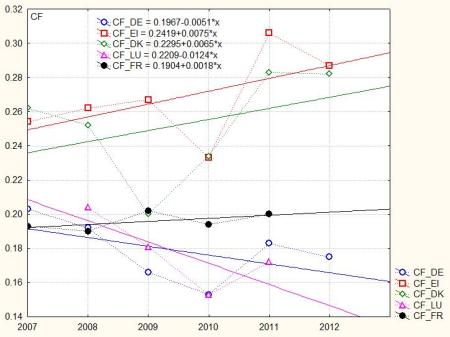This is a new report (in German) from the University of Wien (Austria), which has been discussed by Pierre Gosselin in this blog Notrickszone. The 60 page report is written with the support of 5 institutions:
You should notice the presence of a catholic theological private university, which is a clear sign that the climate discussion mixes religious feelings with science and politics.
I read the 60 pages report carefully and have very mixed feelings. It certainly does not confer a Nobel price, but it has the merit to clearly stress and define the diversity and the common beliefs of the climate realists community. Over large parts, these descriptions are given in neutral and not (too visible) polemic terms, but later on the report rapidly falls back into the downs of the most primitive suggestive wording and one-sided views.
A very annoying, really childish obsession is the feminization of professions: you have the “AkteurInnen”, the “WissentschaftlerInnen”, the “NobelpreisträgerInnen”, the “PolitikerInnenreden” etc… How pity full and laughable is this German politically correct prose, written by a supposed adult university professor who is a Privatdozent of the FU Berlin)! It should be noted that this report is the result of a funding by the Climate and Energy Fund of the Federal State (“managed by Kommunalkredit Public Consulting GmbH, Laufzeit: 01.03.2012 – 31.12.2013″), so the insistence in the report that climate skeptics receive various funding could backfire!
At page 16 the author writes: “Allerdings gibt es auch und diese Gruppe dürfte in der deutlichen Mehrheit sein die Klimaskeptiker, die den menschenverursachten Klimawandel durchaus als wissenschaftlich erwiesenen Tatbestand anerkennen, aber den daraus resultierenden Katastrophismus oder die Klimahysterie ablehnen” . This is an example of what I said about neutrality, and this kind of wording should be the norm in an academic-level report.
Now compare this with page 33: “Dies sind Anknüpfungspunkte für Klimaskeptiker, um Unsicherheiten zu verstärken, Desinformationen zu verbreiten…“. Here the author clearly considers climate skeptics as people who publish disinformation: good climatologists publish information, climate realists disinformation! Say farewell to neutrality, the report is sliding down into diatribe and cheap defamation!
On the same page, Brunnengräber writes how hockey-stick author Michael Mann writes on him being attacked by the climate skeptics… but not a single word on how the hockey-stick team did it’s best to block all publication that they thought “not conform”.
The author also falls into the trap of suggesting that climate skeptics do not publish in peer-reviewed papers, voluntarily ignoring the vast amount of scientific publications… is this due to non-excusable laziness or an “a priori” agenda ? It should be noted that this report received funding over a 10 months period, from 01 March to 31 December 2012.
Suggesting the work of Prof. Mangini from the University of Heidelberg (an eminent specialist of stalagmite use as a temperature proxy) Brunnengräber writes: ” Oder es wird auf nationale Klimaforschungsinstitute Bezug genommen, die wenig bekannt sind, aber mit eigenen Forschungen mit Eisbohrkernen aus der Antarktis, mit Stalagmiten-Analysen oder langjährigen Wetteraufzeichnungen aufwarten ” (pp. 26/27, bold emphasis by me). I do not think that Prof. Mangini’s “Institute of Environmental Physics” is little known, and that the condescending term of “aufwarten” is the correct wording to describe the exceptional work done there in stalagmite datation.
The German EIKE (Europäisches Institut für Klima und Energie) comes out as the most dangerous villain German organization. The author writes on its finances: “ finanziert sich (angeblich) nur durch private Spender..” Why the doubt seeding term of “angeblich” = alleged ? If the author is not sure about the private funding, he should have done his research properly, but he didn’t!
The next important enemies clearly are Fritz Vahrenholt and Sebastian Lüning, the authors of the “Die kalte Sonne“, a book that had the impact of a small atomic bomb in Germany! And in the camp of the “bad” journalists, no surprise, you find Dirk Maxeiner and Michael Miersch which are even labeled industry-lobbyists! Did Brunnengräber even read one single of the truly excellent books of this team?
Conclusion:
The report has been written by a professor of the (leftist) “Forschungszentrum für Umweltpolitik” of the FU-Berlin, and a quick glance at the publications of that institute shows it’s agenda and ideology, and what probably is expected from its members. It is a pity that a report which could have been a possible and valid scientific contribution to the climate debate, has been badly disfigured by the agenda and let’s say it clearly, the one-sided and insufficient research work of its author. I nevertheless suggest you take the time to read it through, and make out your own opinion.
And you climate realists, please take consolation with this old (and slightly modified) German dictum: “Wer andern einen Brunnengräb(er)t, fällt selbst hinein“.








